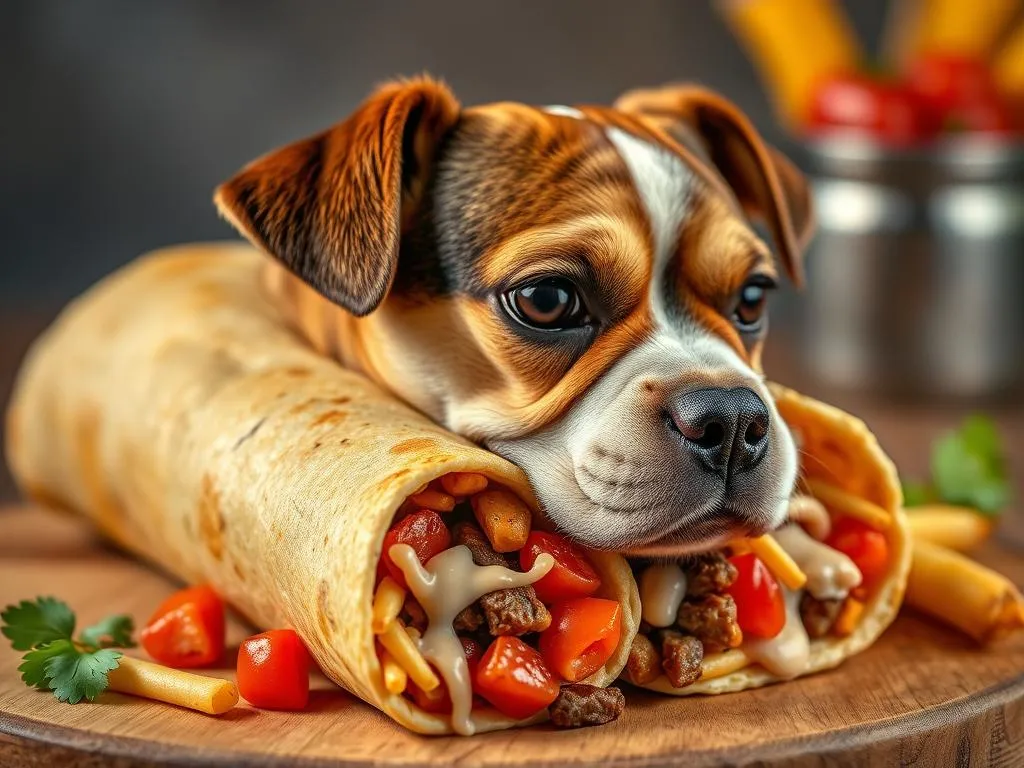
Introduction
When it comes to our furry companions, proper nutrition is pivotal for their overall well-being. A balanced diet can greatly influence their energy levels, coat quality, and even longevity. As dog owners, we often seek to provide the best for our pets, and one delightful way to do this is by preparing dog burrito recipes at home. These recipes not only offer a fun twist to your dog’s meals but also allow you to control the ingredients, ensuring a nutritious feast tailored to your dog’s specific needs.
Dog burrito recipes are versatile and can be customized based on your dog’s preferences and dietary restrictions. Balancing proteins, fats, and carbohydrates in these meals helps maintain your dog’s health, taking into account their age, size, and any underlying health conditions.
Understanding Dog Nutrition
Nutritional Needs of Dogs
Dogs require a balanced diet consisting of essential nutrients to thrive. The primary categories of nutrients include:
- Proteins: Vital for muscle development and repair.
- Fats: Important for energy and promoting healthy skin and coat.
- Carbohydrates: A source of energy and fiber.
- Vitamins and Minerals: Necessary for various bodily functions.
It’s crucial to understand that a dog’s nutritional needs can vary significantly based on factors such as age, breed, size, and any health conditions. For instance, puppies require more protein for growth, while older dogs may need fewer calories to maintain a healthy weight.
Commercial vs. Homemade Dog Food
When it comes to feeding your dog, you have two primary options: commercial dog food and homemade meals.
Commercial dog food offers convenience and is often formulated to meet nutritional guidelines. However, it may contain preservatives and low-quality ingredients.
On the other hand, homemade meals allow you to control the ingredients, ensuring freshness and quality. Preparing meals like dog burrito recipes can be a fun way to bond with your pet while providing them with nutritious options.
Key Ingredients for Dog Burrito Recipes
Protein Sources
When creating dog burrito recipes, protein is a key ingredient. Here are some healthy protein sources to consider:
- Lean Meats: Chicken, turkey, beef, and fish are excellent sources of protein. They provide essential amino acids for muscle health and energy.
- Plant-Based Proteins: Beans and lentils can serve as fantastic, protein-rich alternatives, especially for vegetarian burrito options.
Vegetables
Adding vegetables to your dog burrito recipes can boost their nutritional value. Here are some dog-safe vegetables to include:
- Carrots: High in fiber and vitamins, great for eye health.
- Peas: A good source of protein and essential nutrients.
- Sweet Potatoes: Rich in vitamins A and C, beneficial for skin and coat health.
- Spinach: Packed with iron, vitamins, and antioxidants.
Grains and Carbohydrates
Incorporating grains and carbohydrates is essential for providing energy. Here are some safe options:
- Brown Rice: Easy to digest and a good source of carbohydrates.
- Quinoa: A gluten-free grain high in protein and fiber.
- Oats: Beneficial for digestion and energy.
Healthy Fats
Healthy fats are crucial for maintaining your dog’s skin and coat health. Consider these sources:
- Olive Oil: Rich in omega-3 fatty acids, beneficial for skin health.
- Fish Oil: Supports a healthy coat and can reduce inflammation.
Seasonings and Additives
While seasoning is essential for flavor, be cautious with what you use. Here are some dog-safe herbs and spices:
- Parsley: Good for breath freshening and digestion.
- Turmeric: An anti-inflammatory that can aid in joint health.
Be aware of foods to avoid, such as onions, garlic, and chocolate, as they can be toxic to dogs.
Dog Burrito Recipe Ideas
Basic Chicken Burrito
Ingredients:
- 1 cup cooked chicken, shredded
- ½ cup brown rice, cooked
- ½ cup carrots, diced
- ¼ cup peas
- 1 tablespoon olive oil
- 1 tablespoon parsley, chopped
Preparation Instructions:
- In a large bowl, combine cooked chicken, brown rice, carrots, and peas.
- Drizzle with olive oil and mix well.
- Stir in chopped parsley for added flavor.
- Serve wrapped in a whole wheat tortilla or alone in a bowl.
Nutritional Breakdown: This burrito is packed with protein, fiber, and healthy fats, providing your dog with energy and essential nutrients.
Beef and Sweet Potato Burrito
Ingredients:
- 1 cup ground beef, cooked and drained
- 1 cup sweet potato, cooked and mashed
- ½ cup quinoa, cooked
- ¼ cup spinach, chopped
- 1 tablespoon fish oil
Preparation Instructions:
- In a mixing bowl, combine ground beef, mashed sweet potato, quinoa, and spinach.
- Drizzle with fish oil and mix until well combined.
- Serve in a tortilla or as a meal without the wrap.
Nutritional Breakdown: Rich in protein and healthy carbohydrates, this burrito supports muscle health and provides energy.
Vegetarian Bean Burrito
Ingredients:
- 1 cup black beans, cooked
- ½ cup quinoa, cooked
- ½ cup carrots, grated
- ¼ cup bell peppers, diced
- 1 tablespoon olive oil
- 1 tablespoon turmeric
Preparation Instructions:
- In a bowl, mix black beans, quinoa, grated carrots, and diced bell peppers.
- Drizzle with olive oil and sprinkle turmeric for flavor.
- Serve in a tortilla or as a standalone meal.
Nutritional Breakdown: This vegetarian option is high in fiber and protein, making it an excellent choice for plant-based diets.
Fish and Quinoa Burrito
Ingredients:
- 1 cup cooked fish (salmon or white fish)
- ½ cup quinoa, cooked
- ½ cup peas
- ¼ cup carrots, diced
- 1 tablespoon olive oil
Preparation Instructions:
- In a bowl, combine cooked fish, quinoa, peas, and carrots.
- Drizzle with olive oil and mix gently to avoid breaking the fish.
- Serve wrapped or in a bowl.
Nutritional Breakdown: This recipe is rich in omega-3 fatty acids, promoting a healthy coat and skin.
Customizable Burrito Options
One of the best things about dog burrito recipes is their versatility. You can easily customize these recipes based on your dog’s preferences and dietary restrictions. For instance:
- Substitute chicken with turkey or beef.
- Use different vegetables based on what your dog enjoys.
- Adjust the grains according to dietary needs (e.g., using gluten-free options).
Serving and Storage Tips
Portion Sizes
Determining the right portion size is essential for maintaining your dog’s health. General guidelines suggest:
- Small Dogs: 1/4 to 1/2 cup per meal.
- Medium Dogs: 1/2 to 1 cup per meal.
- Large Dogs: 1 to 2 cups per meal.
These are general guidelines; always adjust based on your dog’s activity level and weight.
Storage Methods
To keep your dog burrito recipes fresh:
- Store leftovers in airtight containers in the refrigerator for up to three days.
- For longer storage, freeze portions in freezer-safe bags or containers. They can last up to three months.
Reheating Instructions
When reheating dog food, ensure it’s warmed to room temperature. Avoid using microwaves, as they can create hot spots that may burn your dog’s mouth. Instead, warm the food in a pan or let it sit at room temperature for a bit.
Monitoring Your Dog’s Health
Signs of Nutritional Deficiencies
It’s essential to monitor your dog’s health, especially when introducing new meals. Watch for signs of nutritional deficiencies, such as:
- Lethargy: Lack of energy can indicate poor nutrition.
- Poor Coat Quality: Dull or brittle fur may suggest inadequate fatty acids.
- Digestive Issues: Frequent vomiting or diarrhea may signal dietary imbalances.
Regular Vet Check-ups
Regular veterinary check-ups are crucial when changing your dog’s diet. A veterinarian can provide tailored advice on nutrition and ensure your pet remains healthy. Regular health assessments can help catch any potential issues early, allowing for prompt intervention.
Conclusion
Providing a balanced diet for your dog is vital to their health and happiness. Dog burrito recipes offer a fun and nutritious way to ensure your furry friend receives all the essential nutrients they need. From chicken to vegetarian options, there’s a burrito for every pup!
Don’t hesitate to experiment with different ingredients and find what your dog loves best. Sharing your experiences and favorite recipes with fellow dog owners can inspire others to explore the joys of homemade meals for their pets.









